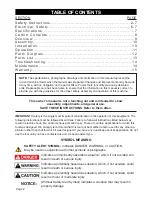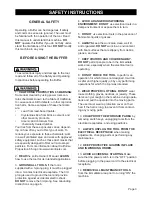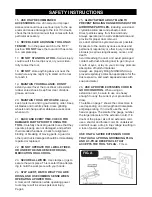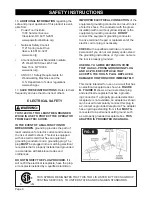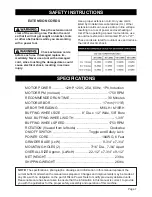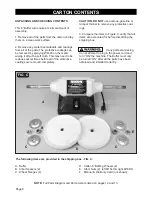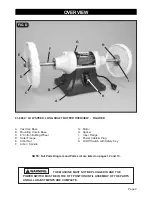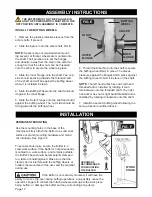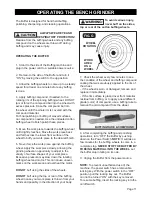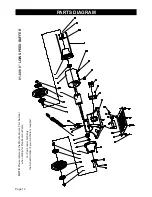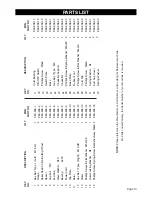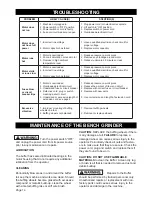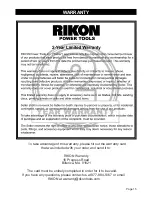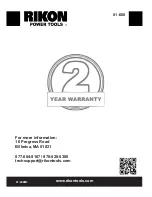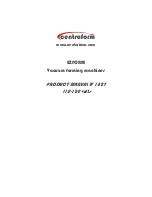
SAFETY INSTRUCTIONS
GENERAL SAFETY
Operating a Buffer can be dangerous if safety
and common sense are ignored. The user must
be familiar with the operation of the tool. Read
this manual to understand this machine.
DO
NOT
operate this Buffer if you do not fully under
-
stand the limitations of this tool.
DO
NOT
modify
this machine in any way.
BEFORE USING THE BUFFER
To avoid serious injury and damage to the tool,
read and follow all of the Safety and Operating
Instructions before operating the Buffer.
1.
CALIFORNIA PROPOSITION 65 WARNING:
Some dust created by using power tools con
-
tains chemicals known to the State of California
to cause cancer, birth defects, or other reproduc
-
tive harm. Some examples of these chemicals
are:
•
Lead from lead-based paints.
•
Crystalline silica from bricks, cement, and
other masonry products.
•
Arsenic and chromium from
chemically treated lumber.
Your risk from these exposures varies, depend
-
ing on how often you do this type of work. To
reduce your exposure to these chemicals: work
in a well ventilated area and work with approved
safety equipment, such as those dust masks that
are specially designed to filter out microscopic
particles. For more information about California
Proposition 65 log onto www.rikontools.com.
2.
READ
the entire Owner’s Manual.
LEARN
how to use the tool for its intended applications.
3.
GROUND ALL TOOLS.
If the tool is
supplied with a 3-prong plug, it must be plugged
into a 3-contact electrical receptacle. The 3rd
prong is used to ground the tool and provide
protection against accidental electric shock.
DO NOT
remove the 3rd prong. See Grounding
Instructions on page 6.
4.
AVOID A DANGEROUS WORKING
ENVIRONMENT. DO NOT
use electrical tools in a
damp environment or expose them to rain.
5.
DO NOT
use electrical tools in the presence of
flammable liquids or gasses.
6.
ALWAYS
keep the work area clean, well lit,
and organized.
DO NOT
work in an environment
with floor surfaces that are slippery from debris,
grease, and wax.
7.
KEEP VISITORS AND CHILDREN AWAY.
DO NOT
permit people to be in the immediate
work area, especially when the electrical tool is
operating.
8.
DO NOT FORCE THE TOOL
to perform an
operation for which it was not designed. It will do
a safer and higher quality job by only performing
operations for which the tool was intended.
9.
WEAR PROPER CLOTHING. DO NOT
wear
loose clothing, gloves, neckties, or jewelry. These
items can get caught in the machine during opera
-
tions and pull the operator into the moving parts.
The user must wear a protective cover on their
hair, if the hair is long, to prevent it from contact
-
ing any moving parts.
10.
CHILDPROOF THE WORKSHOP AREA
by
removing switch keys, unplugging tools from the
electrical receptacles, and using padlocks.
11.
ALWAYS UNPLUG THE TOOL FROM THE
ELECTRICAL RECEPTACLE
when making
adjustments, changing parts or performing any
maintenance.
12.
KEEP PROTECTIVE GUARDS IN PLACE
AND IN WORKING ORDER.
13.
AVOID ACCIDENTAL STARTING.
Make
sure that the power switch is in the “OFF” position
before plugging in the power cord to the electrical
receptacle.
14.
REMOVE ALL MAINTENANCE TOOLS
from the immediate area prior to turning “ON” the
machine.
Page 3


